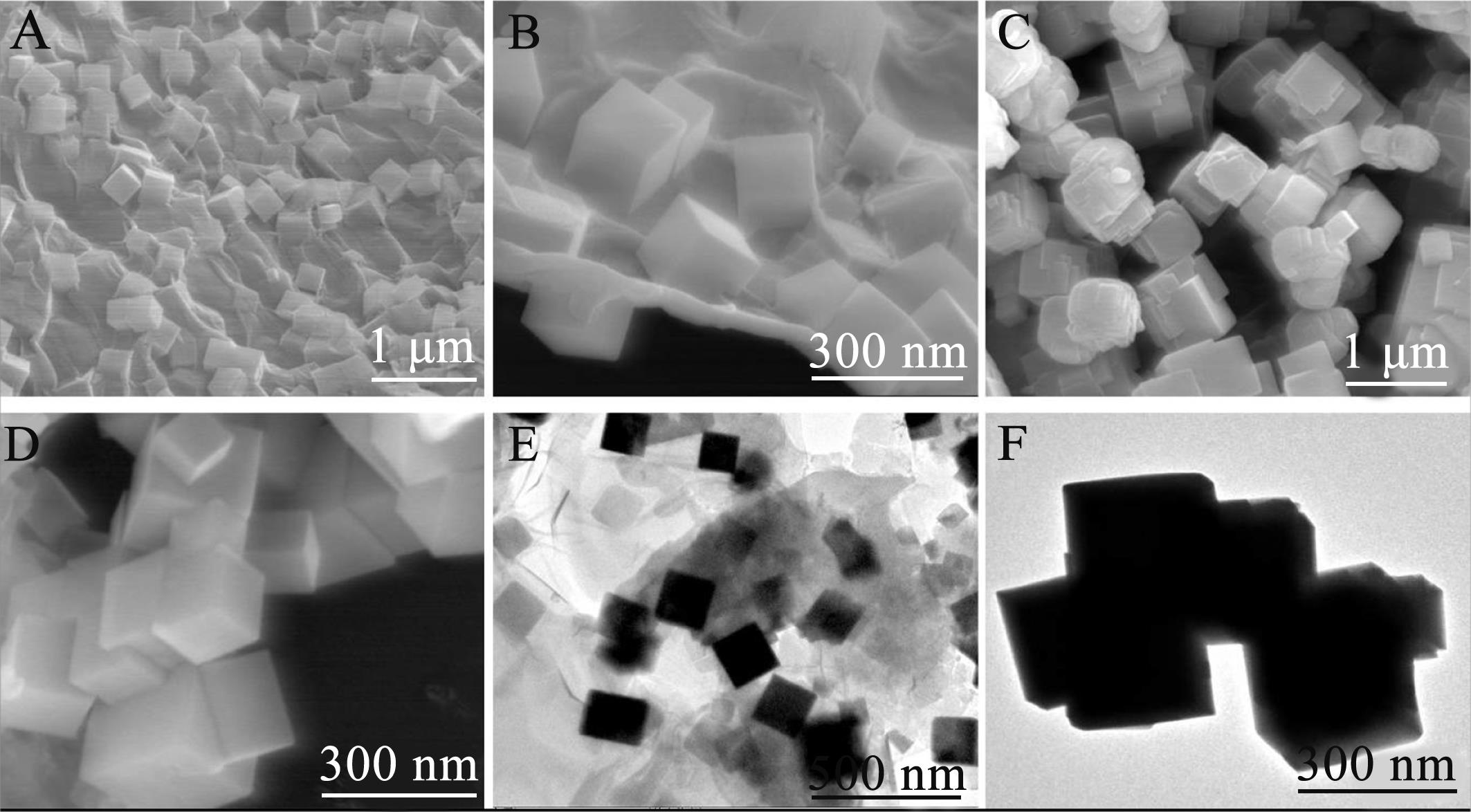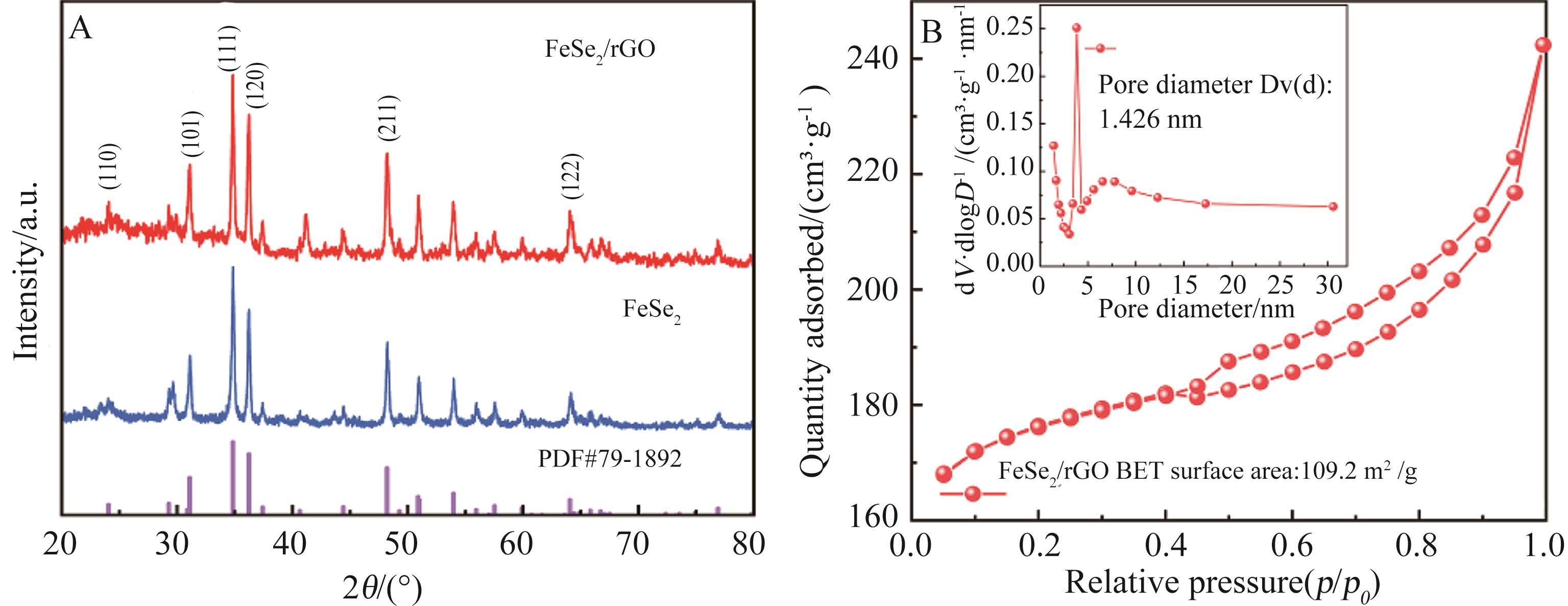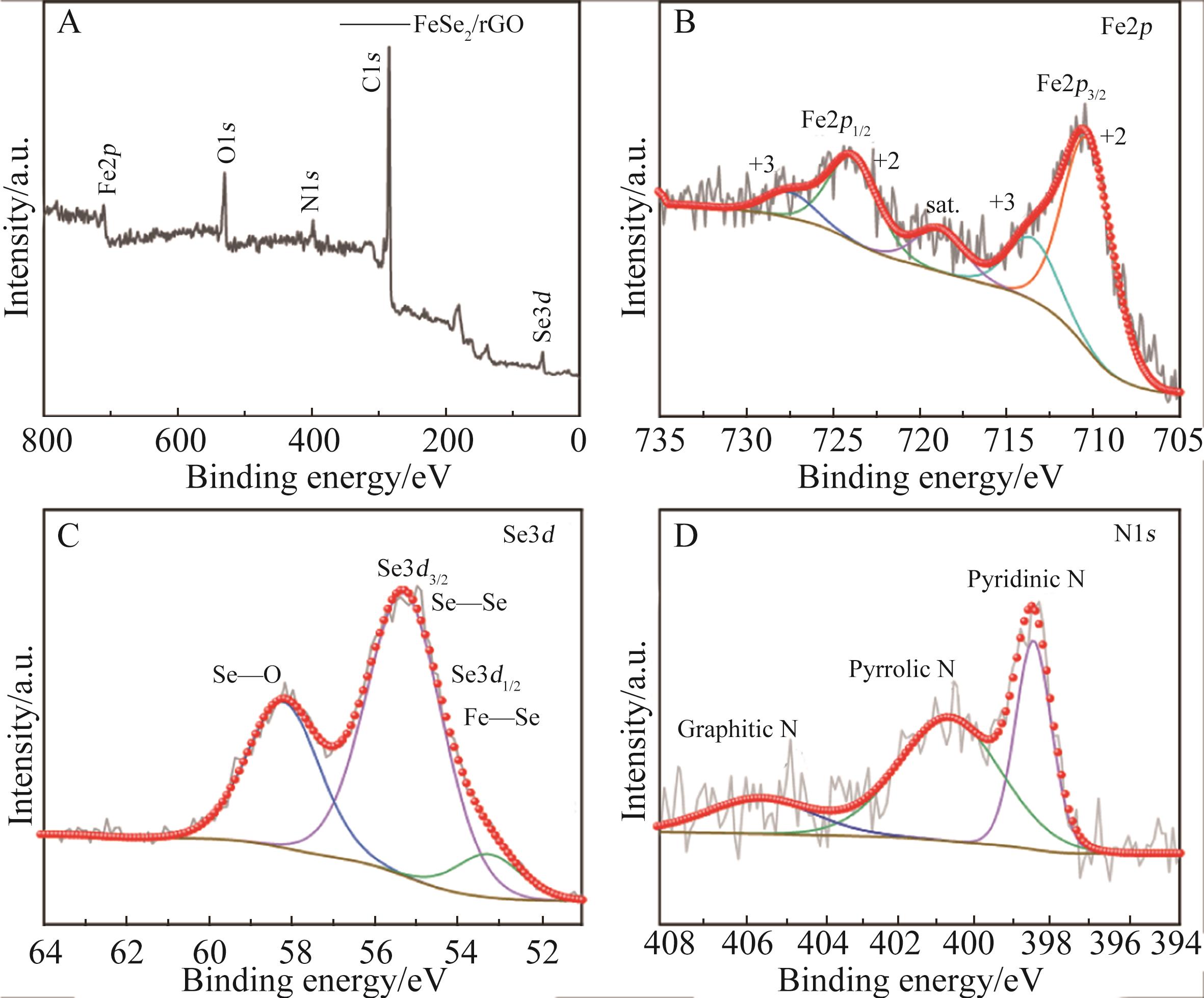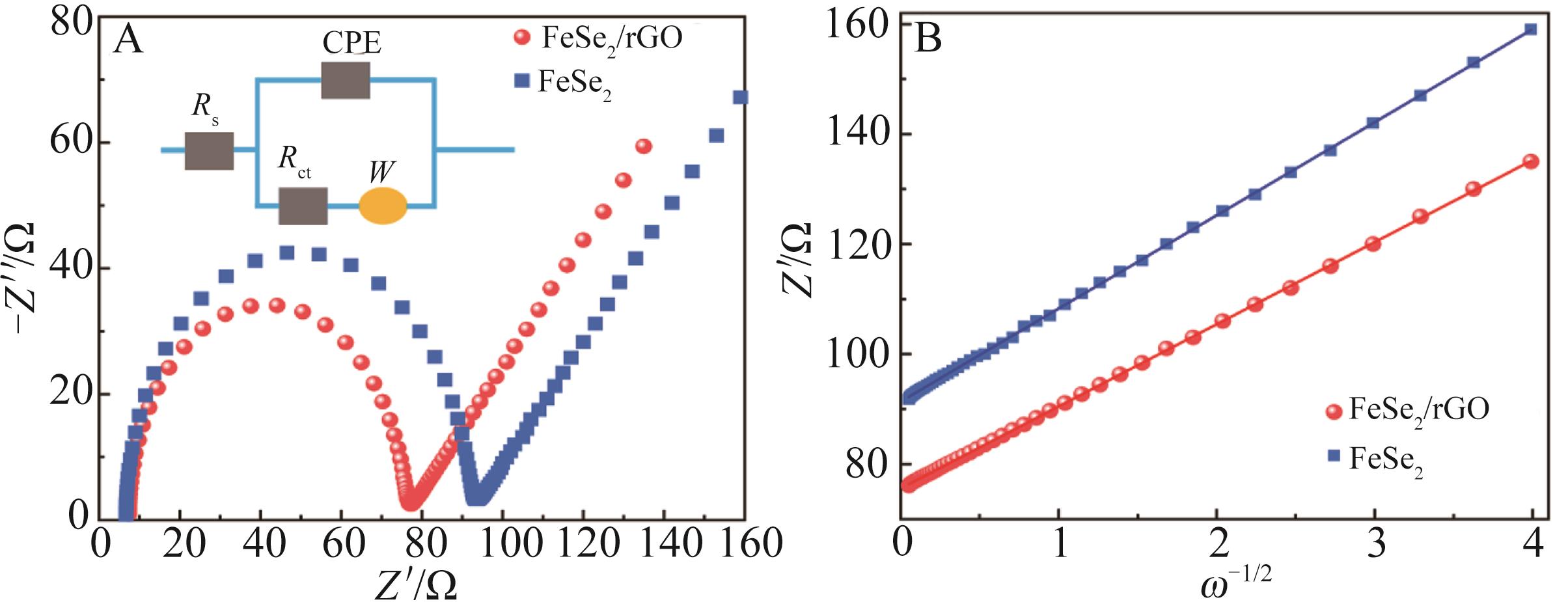
Chinese Journal of Applied Chemistry ›› 2022, Vol. 39 ›› Issue (5): 779-786.DOI: 10.19894/j.issn.1000-0518.210141
• Full Papers • Previous Articles Next Articles
Controllable Construction of Porous Nanocube FeSe2/Graphene Composite for Efficient Na⁃Ion Storage
Fu-Yang WANG1, Wei-Ming SONG1( ), Li SUN1, Jian FENG2, Jun YE1, Zhi-Qi YANG1
), Li SUN1, Jian FENG2, Jun YE1, Zhi-Qi YANG1
- 1.School of Chemistry and Chemical Engineering,Qiqihar University,Qiqihar 161006,China
2.School of Materials Science and Engineering,Northeastern University,Shenyang 110819,China
-
Received:2021-03-24Accepted:2021-07-28Published:2022-05-01Online:2022-05-24 -
Contact:Wei-Ming SONG -
About author:qdsongweiming@163.com
-
Supported by:the Basic Scientific Research Business Expenses of Provincial Colleges and Universities in Heilongjiang Province(135109102);Qiqihar University Postgraduate Innovation Research Project(YJSCX2019038)
CLC Number:
Cite this article
Fu-Yang WANG, Wei-Ming SONG, Li SUN, Jian FENG, Jun YE, Zhi-Qi YANG. Controllable Construction of Porous Nanocube FeSe2/Graphene Composite for Efficient Na⁃Ion Storage[J]. Chinese Journal of Applied Chemistry, 2022, 39(5): 779-786.
share this article
Add to citation manager EndNote|Ris|BibTeX
URL: http://yyhx.ciac.jl.cn/EN/10.19894/j.issn.1000-0518.210141
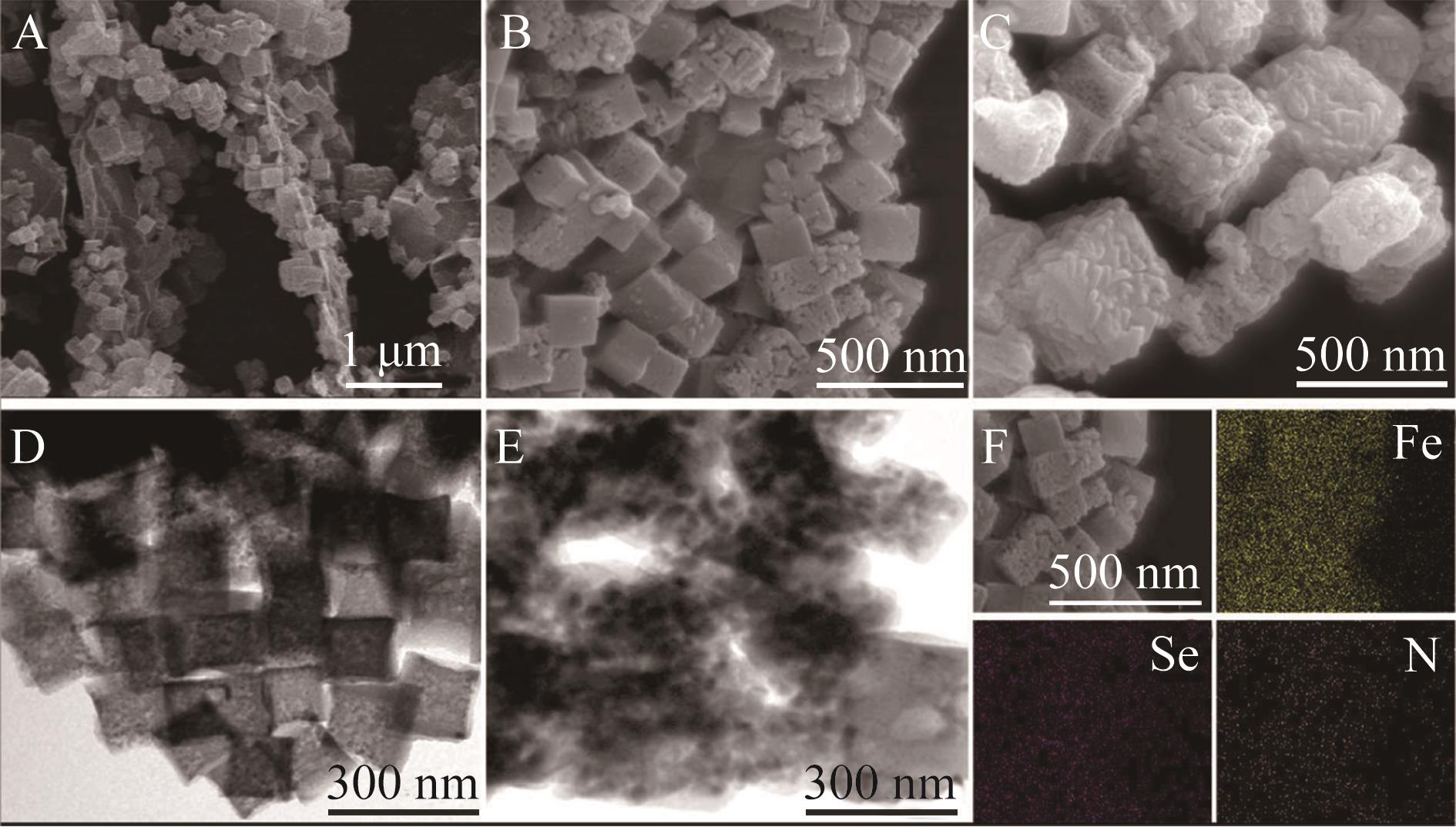
Fig.2 (A, B) SEM images of FeSe2/rGO with different magnifications; (C) SEM images of FeSe2@NC; (D) TEM image of FeSe2/rGO; (E) TEM image of FeSe2@NC; (F) EDS elemental mapping of FeSe2/rGO nanocomposites
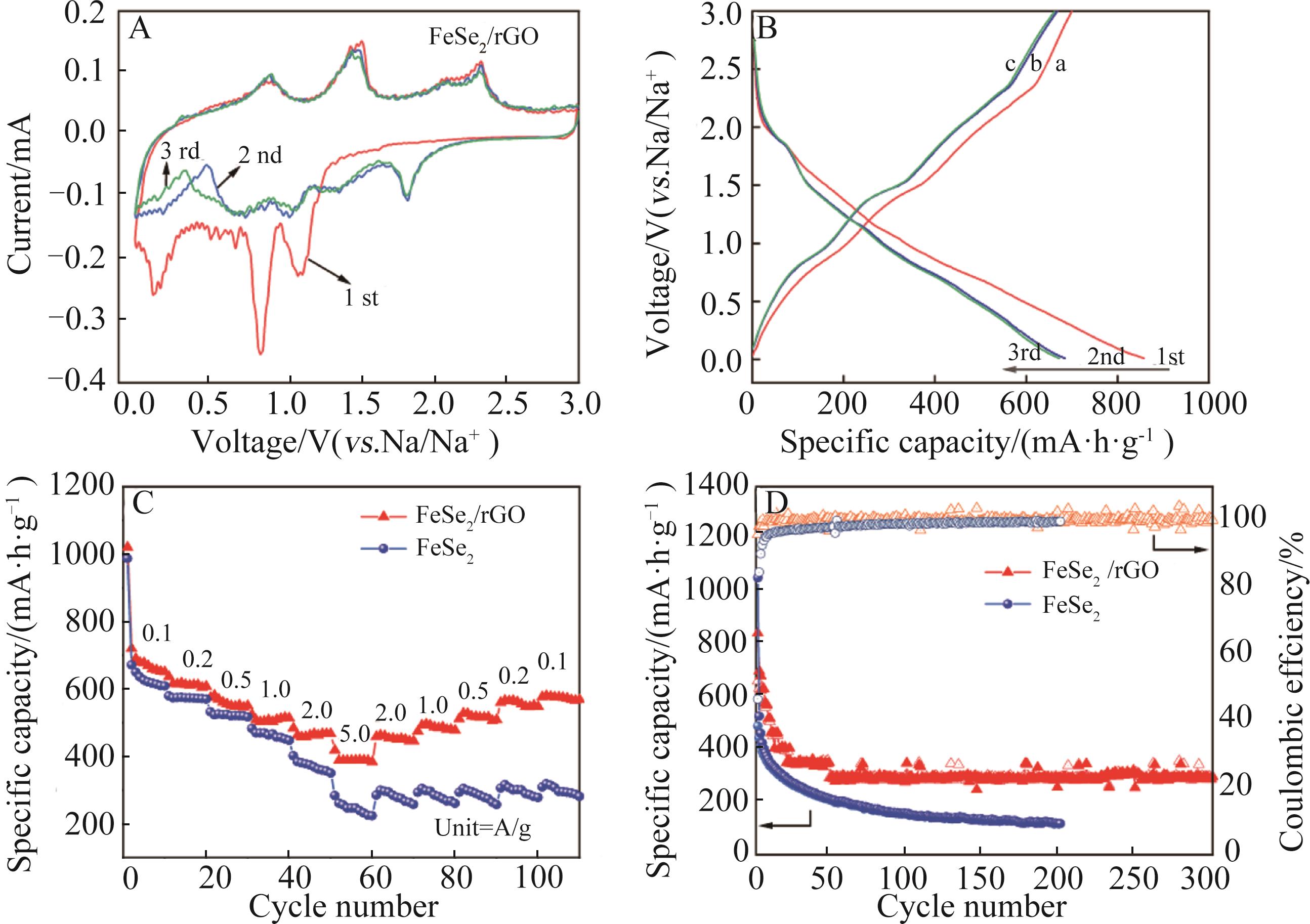
Fig.5 (A) Cyclic voltammogram for initial five cycles at 0.1 mV/s and (B) galvanostatic discharge-charge curves of FeSe2/rGO electrodes at 0.2 A/g; (C) The rate properties of FeSe2@NC, FeSe2/rGO; (D) Cycle performance of FeSe2@NC and FeSe2/rGO electrodes at 2.0 A/g
| 1 | KUBOTA K, DAHBI M, HOSAKA T, et al. Towards K-ion and Na-ion batteries as “beyond Li-ion”[J]. Chem Rec, 2018, 18: 459-479. |
| 2 | DENG J, LUO W B, CHOU S L, et al. Sodium‐ion batteries: from academic research to practical commercialization[J]. Adv Energy Mater, 2018, 8(4): 1701428 |
| 3 | BYEONGYONG L, MYEONGJIN K, SUNKYUNG K, et al. High capacity adsorption-dominated potassium and sodium ion storage in activated crumpled graphene[J]. Adv Energy Mater, 2020, 10(17): 2070076. |
| 4 | MAHMOOD A, LI S, ALI Z, et al. Ultrafast sodium/potassium ion intercalation into hierarchically porous thin carbon shells[J]. Adv Mater, 2018, 31(2): 1805430. |
| 5 | XIE X C, HUANG K J, WU X, et al. Binding hierarchical MoSe2 on MOF-derived N-doped carbon dodecahedron for fast and durable sodium-ion storage[J]. Carbon, 2020, 169: 1-8. |
| 6 | PAN Y L, CHENG X D, VINCENT S, et al. Cagelike CoSe2@N-doped carbon aerogels with pseudocapacitive properties as advanced materials for sodium-ion batteries with excellent rate performance and cyclic stability[J]. ACS Appl Mater Interfaces, 2020, 12(30): 33621-33630. |
| 7 | PAN Q C, ZHANG M, ZHANG L X, et al. FeSe2@C microrods as a superior long-life and high-rate anode for sodium ion batteries[J]. ACS Nano, 2020, 14, 12: 17683-17692. |
| 8 | DONG C F, XU L Q, JIANG F Y, et al. Willow-leaf-like ZnSe@N-doped carbon nanoarchitecture as a stable and high -performance anode material for sodium‐ion and potassium-ion batteries[J]. Small, 2020, 16(47): 2004580. |
| 9 | LUO M, YU H, HU F, et al. Metal selenides for high performance sodium ion batteries[J]. Chem Eng J, 2019, 380: 122557. |
| 10 | PARK J S, YANG S, KANG Y C. Prussian blue analogue nanocubes with hollow interior and porous walls encapsulated within reduced graphene oxide nanosheets and their sodium-ion storage performances[J]. Chem Eng J, 2020, 393: 124606. |
| 11 | HUANG Y X, WANG Z H, CHEN R J, et al. Toward rapid-charging sodium-ion batteries using hybrid-phase molybdenum sulfide selenide-based anodes[J]. Adv Mater, 2020, 32(40): 2003534. |
| 12 | WU X, XU H, SHEN Y, et al. Treatment of graphite felt by modified Hummers method for the positive electrode of vanadium redox flow battery[J]. Electrochim Acta, 2014, 138(25): 264-269. |
| 13 | FENG J, LUO S H, YAN S X, et al. Hierarchically nitrogen-doped carbon wrapped Ni0.6Fe0.4Se2 binary-metal selenide nanocubes with extraordinary rate performance and high pseudocapacitive contribution for sodium-ion anodes[J]. J Mater Chem A, 2021, 9: 1610-1622. |
| 14 | CHEN Y, SHAO J, QU Q T, et al. Hollow structured carbon@FeSe nanocomposite as a promising anode material for Li-ion batteries[J]. ChemElectroChem, 2019, 6, 5: 1393-1399. |
| 15 | CHEN H C, CHEN S, SHU K Y, et al. Bimetallic nickel cobalt selenides: a new kind of electroactive material for high-power energy storage[J]. J Mater Chem A, 2015, 3: 23653-23659 . |
| 16 | XIAO Y, HWANG J, BELHAROUAK I, et al. Na storage capability investigation of a carbon nanotube-encapsulated Fe1- xS composite[J]. ACS Energy Lett, 2017, 2: 364-372. |
| 17 | FAN H S, YU H, ZHANG Y F, et al. 1D to 3D hierarchical iron selenide hollow nanocubes assembled from FeSe2@C core-shell nanorods for advanced sodium ion batteries[J]. Energy Storage Mater, 2018(10): 48-55. |
| 18 | HU Z, LIU Q N, CHOU S L, et al. Advances and challenges in metal sulfides/selenides for next-generation rechargeable sodium-ion batteries[J]. Adv Mater, 2017, 29(48): 1700606. |
| 19 | GE P, HOU H S, JI X B, et al. Tailoring rod-like FeSe2 coated with nitrogen-doped carbon for high-performance sodium storage[J]. Adv Funct Mater, 2018, 28(30): 1801765. |
| 20 | LIU H, JIA M Q, SUN N, et al. Nitrogen-rich mesoporous carbon as anode material for high-performance sodium-ion batteries[J]. ACS Appl Mater Interfaces, 2015, 7(49): 27124-27130. |
| 21 | LI Q, LI L, OWUSU K A, et al. Self-adaptive mesoporous CoS@alveolus-like carbon yolk-shell microsphere for alkali cations storage[J]. Nano Energy, 2017, 41: 109-116. |
| 22 | JIA M, JIN Y, ZHAO C, et al. High electrochemical sodium storage performance of ZnSe/CoSe@N-doped porous carbon synthesized by the in⁃situ selenization of ZIF-8/67 polyhedron[J]. Appl Surf Sci, 2020, 15(518): 146259. |
| 23 | SHI N X, CHU Y T, XI B J, et al. Sandwich structures constructed by ZnSe⊂N-C@MoSe2 located in graphene for efficient sodium storage[J]. Adv Energy Mater, 2020, 10, 14: 2002298. |
| 24 | MENG Y, WANG Y, ZHANG Z, et al. A phytic acid derived LiMn0.5Fe0.5PO4/carbon composite of high energy density for lithium rechargeable batteries[J]. Sci Rep, 2019, 9(1): 6665. |
| 25 | CHO J, LEE J, KANG Y. Graphitic carbon-coated FeSe2 hollow nanosphere-decorated reduced graphene oxide hybrid nanofibers as an efficient anode material for sodium ion batteries[J]. Sci Rep, 2016, 6: 23699. |
| [1] | Fang-Zheng HU, Xing GAO, Lei LIU, Tian-Heng YUAN, Ning CAO, Kai LI, Ya-Tao WANG, Jian-Hua LI, Hui-Qin LIAN, Xiao-Dong WANG, Xiu-Guo CUI. Advances in Black Phosphorus Anode Advantages and Optimization in Li-ion Battery Anodes [J]. Chinese Journal of Applied Chemistry, 2023, 40(4): 571-582. |
| [2] | Xue-Jian SHI, Wan-Qiang LIU, Chun-Li WANG, Yong CHENG, Li-Min WANG. Research Progress of Sb-based Anode Materials for Potassium Ion Batteries [J]. Chinese Journal of Applied Chemistry, 2023, 40(2): 210-228. |
| [3] | WANG Jinying, QU Jiangying, LI Jielan, TANG Zhanlei, ZANG Yunhao, WANG Tao, GU Jianfeng, ZHOU Gang, GAO Feng. Two-Step Coating Synthesis of Silicon/Carbon Composite Based on Coal Tar Pitch and Its Lithium Battery Performance [J]. Chinese Journal of Applied Chemistry, 2020, 37(5): 562-569. |
| [4] | WANG Huanhuan,LU Songtao,QIN Wei,WU Xiaohong. Preparation and Electrochemical Performance of MoS2@Co9S8 Yolk-Shell Nanocomposites [J]. Chinese Journal of Applied Chemistry, 2018, 35(8): 956-962. |
| [5] | Zhaomin WANG, Zheng YI, Ming ZHONG, Yong CHENG, Limin WANG. Research Progress of Antimony-Based Anode Materials for Lithium Ion Batteries [J]. Chinese Journal of Applied Chemistry, 2018, 35(7): 745-755. |
| [6] | LI Bao,LIU Xiaoyang,LI Fan,Esmail Husein M. Salhabib,ZHAO Jilu,WANG Bao. Preparation and Performances of Nano-Micro Structural Ferric Oxide from Flower-Like Iron Alkoxides [J]. Chinese Journal of Applied Chemistry, 2018, 35(3): 356-365. |
| [7] | CHEN Guanghai, BAI Ying, WU Feng, WU Chuan. Two-Dimensional Layered Dicalcium Nitride as Anode Material for Sodium Ion Batteries [J]. Chinese Journal of Applied Chemistry, 2018, 35(3): 366-368. |
| [8] | CHEN Guanghai, BAI Ying, WU Feng, WU Chuan. Two-Dimensional Layered Dicalcium Nitride as Anode Material for Sodium Ion Batteries [J]. Chinese Journal of Applied Chemistry, 2018, 35(3): 0-0. |
| [9] | TAN Jiang, TAN Xi, KANG Wenbin, ZHANG Chuhong. Two Dimensional Molybdenum Disulfide/Graphite Composites Prepared by Direct All-Solid-State Ball-Milling for Lithium-Ion Batteries [J]. Chinese Journal of Applied Chemistry, 2017, 34(7): 810-817. |
| [10] | TAN Jiang, TAN Xi, KANG Wenbin, ZHANG Chuhong. Two Dimensional Molybdenum Disulfide/Graphite Composites Prepared by Direct All-Solid-State Ball-Milling for Lithium-Ion Batteries [J]. Chinese Journal of Applied Chemistry, 2017, 34(7): 0-0. |
| [11] | ZHANG Bin1,2, ZHANG Yibo1, YANG Xiangguang1*. Synthesis and Electrochemical Performance of Reduced Graphene Oxide Coated Cobalt Iron Oxide with Hierarchical Structure [J]. Chinese Journal of Applied Chemistry, 2014, 31(12): 1447-1452. |
| [12] | TANG Anping1,2*, LIU Lihua1,2, XU Guorong1,2, SHEN Jie1, LING Yuling1,2. Progress in Borate Electrode Materials for Lithium Ion Batteries [J]. Chinese Journal of Applied Chemistry, 2012, 29(11): 1221-1230. |
| [13] | ZHANG Kai, BAI Hongmei, CHENG Fangyi, CHEN Jun*. Preparation of Sn Films by Vacuum Evaporation and Their Electrochemical Properties as Lithium-storage Materials [J]. Chinese Journal of Applied Chemistry, 2011, 28(08): 918-923. |
| Viewed | ||||||
|
Full text |
|
|||||
|
Abstract |
|
|||||
